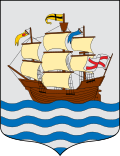You can help expand this article with text translated from the corresponding article in Basque. (February 2013)Click [show] for important translation instructions.
|
This article needs additional citations for verification .(February 2024) |
Portugalete (Portugaldeta) | |
|---|---|
| Noble Villa de Portugalete | |
 Portugalete from Vizcaya Bridge | |
 Location of Portugalete | |
| Coordinates: 43°19′10″N3°1′10″W / 43.31944°N 3.01944°W | |
| Country | Spain |
| Autonomous community | Basque Country |
| Province | Biscay |
| Comarca | Greater Bilbao |
| Founded | 1322 |
| Government | |
| • Alcalde | Mikel Torres Lorenzo (PSE-EE) |
| Area | |
• Total | 3.21 km2 (1.24 sq mi) |
| Elevation | 26 m (85 ft) |
| Population (2018) [1] | |
• Total | 45,826 |
| • Density | 14,000/km2 (37,000/sq mi) |
| Demonym(s) | Portugalujo/a, Jarrillero/a, Portulano/a |
| Time zone | UTC+1 (CET) |
| • Summer (DST) | UTC+2 (CEST) |
| Postal code | 48920 |
| Official language(s) | Basque and Spanish |
| Website | Official website |
Portugalete is a town lying to the west of Bilbao in the province of Biscay in the Autonomous Community of the Basque Country, northern Spain.
Contents
- Etymology
- Transporter bridge
- Demographics
- Festivals
- San Roque Festivals
- Monuments
- See also
- References
- External links
The town has 45,294 inhabitants as of 2021 and is part of Bilbao's metropolitan area. It is located at the mouth of the Estuary of Bilbao, on the left bank. Its land area is only 3.21 km², resulting in a population density of 15,908.4 persons/km², the fifth-most densely populated municipality in Spain (following Mislata, L'Hospitalet de Llobregat, Benetússer, and Santa Coloma de Gramenet). It was established in 1322 by María Díaz de Haro. [2]



